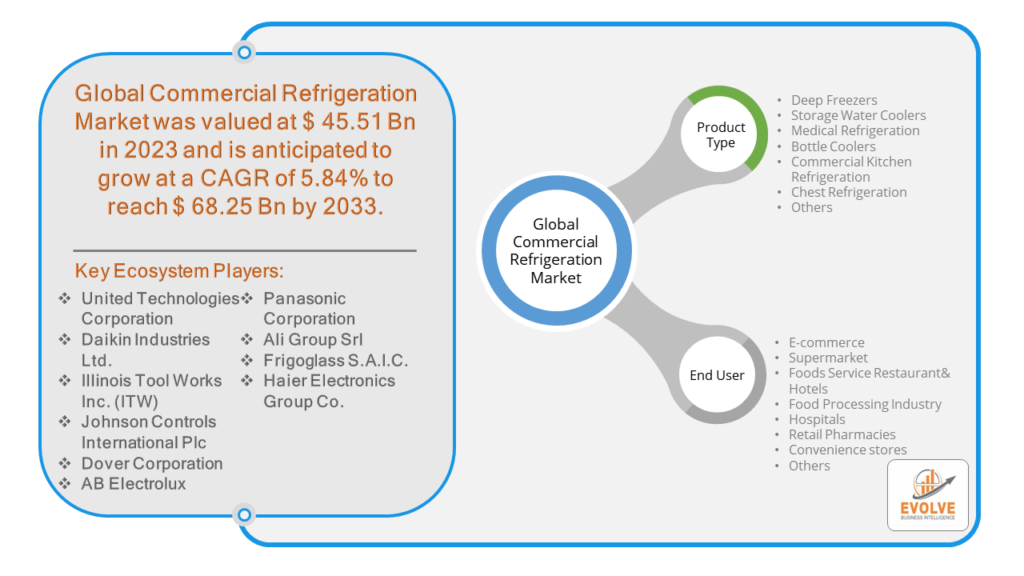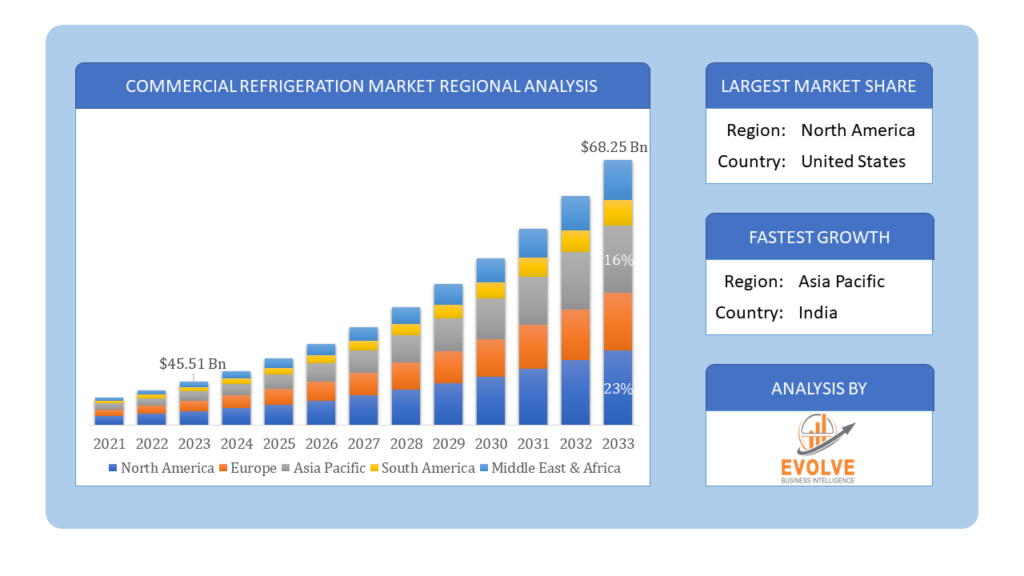Commercial Refrigeration Market Overview
The Commercial Refrigeration Market Size is expected to reach USD 68.25 Billion by 2033. The Commercial Refrigeration Market industry size accounted for USD 45.51 Billion in 2023 and is expected to expand at a compound annual growth rate (CAGR) of 5.84% from 2023 to 2033. The Commercial Refrigeration Market refers to the industry that encompasses the manufacturing, distribution, and sale of refrigeration equipment and systems designed for use in commercial settings. This market includes a wide range of products used to preserve and store perishable goods, such as food and beverages, in environments like supermarkets, convenience stores, restaurants, hotels, and other businesses.
The market is driven by factors such as the growth of the food and beverage industry, increasing urbanization, rising demand for frozen and chilled food products, and technological advancements in refrigeration systems. Energy efficiency, sustainability, and compliance with environmental regulations are also significant trends influencing the commercial refrigeration market.
Global Commercial Refrigeration Market Synopsis
The COVID-19 pandemic had a significant impact on the Commercial Refrigeration Market. The pandemic caused disruptions in global supply chains, leading to delays in the production and delivery of refrigeration equipment. Manufacturing plants faced shutdowns or reduced operations, affecting the availability of components and finished products. With the rise in online grocery shopping and home deliveries, there was an increased demand for refrigerated transport and storage solutions. Supermarkets and food retailers needed more refrigeration capacity to handle the surge in demand for perishable goods. The pandemic heightened the focus on health and safety, leading to innovations in refrigeration technology. There was an increased interest in equipment that could maintain consistent temperatures and reduce the risk of contamination, such as touchless operation and improved air filtration systems. The economic uncertainty caused by the pandemic led to cautious spending by businesses. Many companies delayed capital expenditures, including investments in new refrigeration equipment, to conserve cash and navigate the uncertain economic environment.
Commercial Refrigeration Market Dynamics
The major factors that have impacted the growth of Commercial Refrigeration Market are as follows:
Drivers:
Ø Technological Advancements
The expansion of the food and beverage sector, including supermarkets, convenience stores, restaurants, and food processing facilities, fuels the demand for commercial refrigeration equipment to store and preserve perishable goods. Increasing urbanization and changing consumer lifestyles lead to higher demand for frozen and chilled food products, driving the need for efficient refrigeration solutions in urban retail and foodservice establishments. Innovations in refrigeration technology, such as improved energy efficiency, advanced temperature control, and eco-friendly refrigerants, attract businesses looking to reduce operating costs and meet environmental regulations. Increasing consumption of frozen and processed foods, driven by busy lifestyles and the convenience of ready-to-eat meals, supports the growth of the commercial refrigeration market.
Restraint:
- Perception of High Initial Costs
The substantial capital investment required for purchasing and installing advanced commercial refrigeration equipment can be a significant barrier for small and medium-sized enterprises (SMEs). The high upfront costs can deter businesses from upgrading or investing in new systems. Commercial refrigeration systems are energy-intensive, leading to high operational costs. Businesses may be reluctant to adopt new refrigeration solutions due to concerns about ongoing energy expenses, especially in regions with high electricity prices. Advanced refrigeration systems often involve complex technology that requires specialized knowledge for installation, operation, and maintenance. A lack of skilled technicians can impede the adoption of these systems, particularly in emerging markets.
Opportunity:
⮚ Adoption of Green Refrigerants
Increasing environmental awareness and regulatory pressures are driving the shift towards eco-friendly refrigerants, such as hydrofluoroolefins (HFOs) and natural refrigerants like CO2 and ammonia. Companies can capitalize on this trend by developing and promoting environmentally sustainable refrigeration solutions. There is a growing demand for energy-efficient refrigeration systems that can reduce operational costs and minimize environmental impact. Innovations such as variable speed compressors, advanced insulation materials, and smart energy management systems offer significant opportunities for manufacturers. The rise of e-commerce and online grocery shopping, accelerated by the COVID-19 pandemic, has created a demand for efficient refrigerated storage and transportation solutions. Businesses can invest in specialized equipment to cater to the logistics needs of the online food delivery market.
Commercial Refrigeration Market Segment Overview
By Product Type
 Based on Product Type, the market is segmented based on Deep Freezers, Storage Water Coolers, Medical Refrigeration, Bottle Coolers, Commercial Kitchen Refrigeration, Chest Refrigeration and Others. Chest refrigerators represent the largest segment in the market, attributed to their widespread use across various industries. These refrigerators are known for their energy efficiency and large storage capacity, making them ideal for storing bulky items or large quantities of products. Commonly used in supermarkets, convenience stores, and the hospitality sector, chest refrigerators are favored for their durability and ease of maintenance. Their versatility in temperature control also makes them suitable for a range of products, from perishable food items to beverages.
Based on Product Type, the market is segmented based on Deep Freezers, Storage Water Coolers, Medical Refrigeration, Bottle Coolers, Commercial Kitchen Refrigeration, Chest Refrigeration and Others. Chest refrigerators represent the largest segment in the market, attributed to their widespread use across various industries. These refrigerators are known for their energy efficiency and large storage capacity, making them ideal for storing bulky items or large quantities of products. Commonly used in supermarkets, convenience stores, and the hospitality sector, chest refrigerators are favored for their durability and ease of maintenance. Their versatility in temperature control also makes them suitable for a range of products, from perishable food items to beverages.
By End User
Based on End User, the market segment has been divided into the E-commerce, Supermarket/ Hypermarket, Foods Service Restaurant& Hotels, Food Processing Industry, Hospitals, Retail Pharmacies, Convenience stores and Others. The Foods Service Restaurant& Hotels segment is dominant the market. Energy-efficient refrigeration units are highly valued to reduce operating costs, especially in establishments with high energy consumption like restaurants and hotels. There is a growing trend towards environmentally friendly refrigeration solutions that use natural refrigerants and have lower greenhouse gas emissions.
Global Commercial Refrigeration Market Regional Analysis
Based on region, the global Commercial Refrigeration Market has been divided into North America, Europe, Asia-Pacific, the Middle East & Africa, and Latin America. North America is projected to dominate the use of the Commercial Refrigeration Market followed by the Asia-Pacific and Europe regions.
 Commercial Refrigeration North America Market
Commercial Refrigeration North America Market
North America holds a dominant position in the Commercial Refrigeration Market. North America, particularly the United States and Canada, has a mature commercial refrigeration market characterized by high demand for energy-efficient and environmentally friendly refrigeration solutions. Strict regulations on refrigerants and energy efficiency standards drive the adoption of advanced technologies and green refrigerants. Increasing demand for frozen and ready-to-eat food products, coupled with the growth of the foodservice and retail sectors, supports market growth. The rise of e-commerce and online grocery shopping further boosts the need for efficient refrigeration logistics.
Commercial Refrigeration Asia-Pacific Market
The Asia-Pacific region has indeed emerged as the fastest-growing market for the Commercial Refrigeration Market industry. The Asia-Pacific region is experiencing rapid growth in the commercial refrigeration market due to increasing urbanization, rising disposable incomes, and the expansion of the retail and foodservice sectors. Varying regulatory frameworks across countries, with some regions beginning to adopt stricter environmental standards. High demand for advanced refrigeration solutions driven by the booming food and beverage industry, growth of supermarkets and hypermarkets, and the rise of e-commerce. Energy-efficient and cost-effective solutions are particularly sought after in this price-sensitive market.
Competitive Landscape
The global Commercial Refrigeration Market is highly competitive, with numerous players offering a wide range of software solutions. The competitive landscape is characterized by the presence of established companies, as well as emerging startups and niche players. To increase their market position and attract a wide consumer base, the businesses are employing various strategies, such as product launches, and strategic alliances.
Prominent Players:
- United Technologies Corporation
- Daikin Industries Ltd.
- Illinois Tool Works Inc. (ITW)
- Johnson Controls International Plc
- Dover Corporation
- AB Electrolux
- Panasonic Corporation
- Ali Group Srl
- Frigoglass S.A.I.C.
- Haier Electronics Group Co.
Key Development
In January 2022, A Carrier Commercial Refrigeration PowerCO2OL refrigeration system was installed at a COVID-19 vaccine storage warehouse in Spain. This device employs carbon dioxide, a natural refrigerant, as a sustainable and low-GWP refrigerant to aid in the preservation of essential vaccines in Spain.
Scope of the Report
Global Commercial Refrigeration Market, by Product Type
- Deep Freezers
- Storage Water Coolers
- Medical Refrigeration
- Bottle Coolers
- Commercial Kitchen Refrigeration
- Chest Refrigeration
- Others
Global Commercial Refrigeration Market, by End User
- E-commerce
- Supermarket
- Foods Service Restaurant& Hotels
- Food Processing Industry
- Hospitals
- Retail Pharmacies
- Convenience stores
- Others
Global Commercial Refrigeration Market, by Region
- North America
- US
- Canada
- Mexico
- Europe
- UK
- Germany
- France
- Italy
- Spain
- Benelux
- Nordic
- Rest of Europe
- Asia Pacific
- China
- Japan
- South Korea
- Indonesia
- Austalia
- Malaysia
- India
- Rest of Asia Pacific
- South America
- Brazil
- Argentina
- Rest of South America
- Middle East & Africa
- Saudi Arabia
- UAE
- Egypt
- South Africa
- Rest of Middle East & Africa
| Parameters | Indicators |
|---|---|
| Market Size | 2033: $68.25 Billion |
| CAGR | 5.84% CAGR (2023-2033) |
| Base year | 2022 |
| Forecast Period | 2023-2033 |
| Historical Data | 2021 |
| Report Coverage | Revenue Forecast, Competitive Landscape, Growth Factors, and Trends |
| Key Segmentations | Product Type, End User |
| Geographies Covered | North America, Europe, Asia-Pacific, Latin America, Middle East, Africa |
| Key Vendors | United Technologies Corporation, Daikin Industries Ltd., Illinois Tool Works Inc. (ITW), Johnson Controls International Plc, Dover Corporation, AB Electrolux, Panasonic Corporation, Ali Group Srl, Frigoglass S.A.I.C. and Haier Electronics Group Co. |
| Key Market Opportunities | • Adoption of Green Refrigerants • Growth of Online Grocery and Food Delivery Services |
| Key Market Drivers | • Technological Advancements • Growth in the Food and Beverage Industry |
REPORT CONTENT BRIEF:
- High-level analysis of the current and future Commercial Refrigeration Market trends and opportunities
- Detailed analysis of current market drivers, restraining factors, and opportunities in the future
- Commercial Refrigeration Market historical market size for the year 2021, and forecast from 2023 to 2033
- Commercial Refrigeration Market share analysis at each product level
- Competitor analysis with detailed insight into its product segment, Government & Defense strength, and strategies adopted.
- Identifies key strategies adopted including product launches and developments, mergers and acquisitions, joint ventures, collaborations, and partnerships as well as funding taken and investment done, among others.
- To identify and understand the various factors involved in the global Commercial Refrigeration Market affected by the pandemic
- To provide a detailed insight into the major companies operating in the market. The profiling will include the Government & Defense health of the company’s past 2-3 years with segmental and regional revenue breakup, product offering, recent developments, SWOT analysis, and key strategies.








